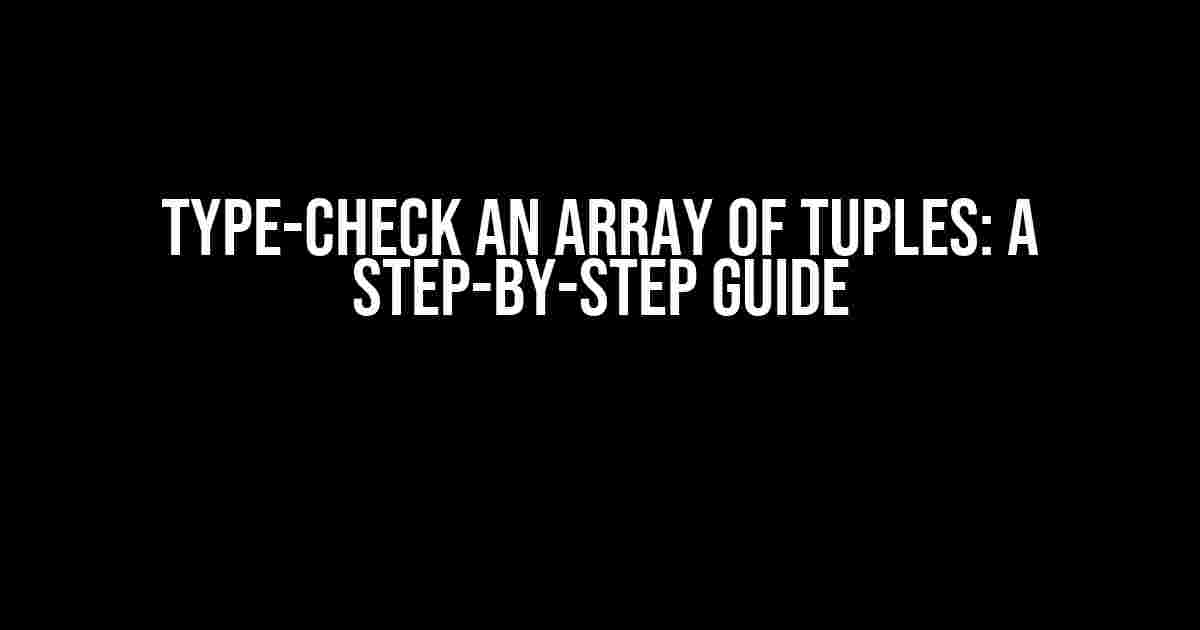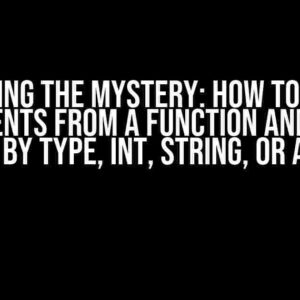Type checking is an essential aspect of programming, ensuring that the variables and data structures in your code conform to the expected types. When working with arrays of tuples, type checking becomes even more critical to avoid errors and ensure data integrity. In this article, we’ll delve into the world of type checking and explore how to type-check an array of tuples efficiently.
What are Tuples?
Before we dive into type checking, let’s quickly revisit what tuples are. In programming, a tuple is a collection of values of different data types, similar to an array or list. However, unlike arrays, tuples are immutable, meaning their values cannot be changed once created. Tuples are often used to store related data, such as a person’s name, age, and address.
Why Type-check an Array of Tuples?
Type checking an array of tuples is crucial for several reasons:
- Data Integrity**: Type checking ensures that each tuple in the array conforms to the expected data type, preventing errors and data corruption.
- Code Readability**: By defining the expected types, you make your code more readable and easier to understand for other developers.
- Code Maintenance**: Type checking helps catch errors early on, reducing the time spent debugging and maintaining your code.
Basic Type Checking with TypeScript
For this example, we’ll use TypeScript, a superset of JavaScript that adds optional static typing and other features. If you’re new to TypeScript, don’t worry; the concepts apply to other languages as well.
Let’s create a simple array of tuples using TypeScript:
let arr: [string, number][] = [
['John', 25],
['Alice', 30],
['Bob', 35]
];In this example, we define an array `arr` with the type `[string, number][]`, indicating that each element in the array is a tuple containing a string and a number.
Type Checking with Interfaces
Interfaces are a powerful tool in TypeScript for defining custom types. Let’s create an interface to type-check our array of tuples:
interface Person {
name: string;
age: number;
}
let arr: Person[] = [
{ name: 'John', age: 25 },
{ name: 'Alice', age: 30 },
{ name: 'Bob', age: 35 }
];In this example, we define an interface `Person` with two properties: `name` (string) and `age` (number). We then use this interface to type-check our array `arr`, ensuring that each element conforms to the `Person` interface.
Advanced Type Checking with Generics
Generics are a feature in TypeScript that allow you to create reusable functions and types that work with multiple data types. Let’s create a generic function to type-check an array of tuples:
function typeCheckArray<T>(arr: T[]): void {
arr.forEach((tuple: T) => {
if (!Array.isArray(tuple)) {
throw new Error('Each element in the array must be a tuple');
}
tuple.forEach((value: any) => {
if (typeof value !== 'string' && typeof value !== 'number') {
throw new Error('Each tuple must contain only strings and numbers');
}
});
});
}
let arr = [
['John', 25],
['Alice', 30],
['Bob', 35]
];
typeCheckArray(arr);In this example, we define a generic function `typeCheckArray` that takes an array of type `T[]` as an argument. We then use TypeScript’s built-in `Array.isArray()` function to check if each element in the array is a tuple. Finally, we iterate over each tuple and check if each value is either a string or a number, throwing an error if not.
Type Checking with Type Guards
Type guards are a feature in TypeScript that allow you to narrow the type of a value within a specific scope. Let’s create a type guard to check if an array is an array of tuples:
function isArrayOfTuples(arr: any[]): arr is [string, number][] {
return arr.every((tuple: any[]) => tuple.length === 2 && typeof tuple[0] === 'string' && typeof tuple[1] === 'number');
}
let arr = [
['John', 25],
['Alice', 30],
['Bob', 35]
];
if (isArrayOfTuples(arr)) {
console.log('Array is an array of tuples');
} else {
console.log('Array is not an array of tuples');
}In this example, we define a type guard function `isArrayOfTuples` that takes an array as an argument and returns a boolean indicating whether the array is an array of tuples. We then use this function to check if our array `arr` is an array of tuples, logging a message to the console accordingly.
Conclusion
In this article, we’ve explored the importance of type checking an array of tuples and discussed various methods to achieve this using TypeScript. By using interfaces, generics, and type guards, you can ensure that your arrays of tuples are type-safe and error-free. Remember, type checking is an essential part of programming, and by following these best practices, you’ll write more maintainable and efficient code.
| Method | Description |
|---|---|
| Basic Type Checking | Using TypeScript’s built-in type system to define an array of tuples. |
| Type Checking with Interfaces | Defining a custom interface to type-check an array of tuples. |
| Advanced Type Checking with Generics | Using generics to create a reusable function for type checking an array of tuples. |
| Type Checking with Type Guards | Using type guards to narrow the type of an array and check if it’s an array of tuples. |
By applying these techniques, you’ll be well on your way to writing robust and type-safe code. Happy coding!
Frequently Asked Question
Get the scoop on type-checking arrays of tuples!
What is type-checking for an array of tuples?
Type-checking for an array of tuples is the process of verifying that each element in the array conforms to a specific tuple type. It ensures that each tuple has the correct number and type of elements, making your code more robust and error-free.
Why is type-checking important for arrays of tuples?
Type-checking is crucial for arrays of tuples because it helps catch errors early, prevents data corruption, and makes your code more maintainable. Without type-checking, you might end up with incorrect or inconsistent data, leading to bugs and errors that can be difficult to track down.
How do I type-check an array of tuples in TypeScript?
In TypeScript, you can type-check an array of tuples using the `TupleType` notation. For example, `let myArray: [string, number][] = [[“hello”, 1], [“world”, 2]];`. This ensures that each element in the array is a tuple with a string and a number, respectively.
Can I use type-checking for arrays of tuples in JavaScript?
While JavaScript itself doesn’t have built-in type-checking, you can use tools like Flow or TypeScript to add type-checking to your JavaScript code. These tools allow you to define types for your variables and ensure that they conform to those types at compile-time.
What are some best practices for type-checking arrays of tuples?
Some best practices for type-checking arrays of tuples include defining clear and concise type definitions, using consistent naming conventions, and regularly reviewing and updating your type definitions as your code evolves. Additionally, consider using automated tools to help catch type-related errors and make your code more maintainable.



